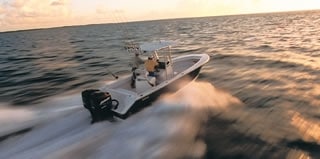
To say that marine propulsion has gotten more sophisticated in the past few years is a bit of an understatement. When environmental regulations demanded a major cleanup of two-stroke technology, the resultant rethinking by engine manufacturers gave us a lot more than just cleaner exhaust. The entire design of outboard power has undergone scrutiny, and the bar has been raised overall on economy, performance and ease of operation. In short, boating has gotten better, easier and more efficient, and one of the fortunate spin-offs for anglers in this evolution is the availability and sophistication of electronic throttle and shift controls.
It’s impossible to have any discussion of electronic controls without the name Glendinning popping up. Well known for the sophistication of its control systems, Glendinning boasts a backup system that provides exceptional reliability. Builders of large sport-fishing boats such as Cabo, Ocean, Garlington, Post, Scarborough, Merritt and Albemarle are just a few of its customers. The bulk of Glendinning’s business has been in the 35-foot-and-over market.
John Glendinning, vice-president of Glendinning Marine Products Inc., has been in the electronic-control business since 1993, and is well acquainted with the history of the technology – and the advantage it offers over mechanical controls. “I would submit that engine control is the third most critical system in the boat,” says Glendinning. “The hull is first, followed by the through-hull fittings, and the third is the engine control. You can lose your steering and still continue your trip, but you can’t lose your controls.”
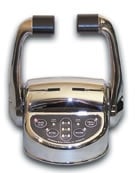
Glendinning’s EEC-2001 electronic engine controls offer quick, responsive performance and a wide range of features. (above left) Mercury’s Digital Throttle & Shift System is currently available on the 225 OptiMax, but will soon be expanded to other engine models.|
That established, Glendinning explained that the obvious advantage of electronic controls is dependability. “Ultimately, it is a more reliable system than a mechanical interface,” he says. “A whole lot of things can go wrong with mechanical systems. We have seen cables on the transmission about to fall off due to a missing nut, and cables that came off their mounting locations.”
Since cable failure is eliminated with electronic controls, it’s easy to understand why commercial fishermen first became interested in them. In fact, that’s where the whole concept of electronic controls first surfaced.
Early Systems
“The first companies to get involved in electronic controls were Detroit Diesel and Mathers,” explained Glendinning. “Detroit introduced its DDEC product and simultaneously Mathers – which has been in biz for 30 years, making pneumatic controls for commercial fishing boats in the Northwest – developed the electronic fly-by-wire technology. This was right around 1987. They were the pioneers in the market.” ZF Mathers currently manufactures the MicroCommander, a control system customized for Cummins, MTU, Caterpillar, Volvo, Rolls Royce, MAN, Detroit and Yanmar engines, among others. Subsequently, other companies joined in.
“In ’91 or ’92, Twin Disc had a product that was derived from the M1A1 battle tank. And Morse put several products on the market in the mid-’90s, for recreational boats,” Glendinning explained.
Morse, currently owned by Teleflex, still offers the KE-4 electronic control. It’s sold primarily for outboard boats, and is readily available as an aftermarket option with easy plug-and-play installation. Morse remains the veteran in the recreational- and fishing-boat market.
“We began making controls in 1993,” Glendinning continued. “We looked at what was out there and decided we could do a better job. Much of what was on the market was based on using a potentiometer. In order to avoid interference from other electronics, we developed the serial communications interface. Lots of things can go wrong, so the idea of an all-electronic interface is likely to become more and more popular.
“We came out with a serial communication interface and so did Sturdy, and that was the genesis.” Sturdy, of Wilmington, North Carolina, included a twin-engine synchronizer with a synch mode that turned control of more than one engine over to a single lever. Currently, Sturdy produces the MPCS electronic diesel interface for Caterpillar and Cummins engines.
How It Works
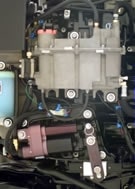
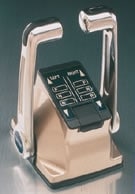
(top) Mercury’s DTS system effectively eliminates response lag by making the throttle and shift controllers an integral part of the engine. (bottom) The KE-4 from Teleflex Morse is a popular aftermarket option for outboard boats.|
Virtually all electronic throttle and gear controls were – with the exception of Morse – designed originally for inboard, commercial applications. After all, that’s where the development of electronic throttle and solenoid-driven transmissions took place. The technology, as it has filtered down to outboard applications, has remained fairly consistent in terms of how it works. The throttle and shift levers are connected electrically to an actuator box, which (with the exception of Mercury’s DTS system) contains motors that activate a set of short cables that connect to the proper levers on the motor. The introduction of the electronic module at the throttle end allows a number of programmable controls such as single-lever, dual-engine operation; high-rpm sensors to prevent directional changes at speeds that would damage gears; and minute changes in throttle settings for trolling-speed adjustments.
A recent arrival on the recreational scene is Tech Marine. Like Morse, Tech Marine has focused on the pleasure- and fishing-boat market. It offers an aftermarket system that is well designed, strong and versatile enough to handle the variety of engine configurations – both outboard and inboard – found on fishing boats around the country. Tech Marine also offers the option of push-button gearbox control.
Three years ago, Teleflex introduced an electronic control system that is also part of its high-speed information system known as “Magic Bus.” The Teleflex configuration offers a tremendous range of options. “When we introduced the dual-engine model,” said Joe Zablocki, New Business Develop-ment Manager for Teleflex, “people started asking us about triples. As soon as we introduced the triple-engine system, they started asking about quads.” So far, Teleflex has provided it all.
Single-lever control with duals is elementary to the system. In the case of triples, you can make one lever control engine selection, but you can also determine what happens to the center engine when the transmissions disagree. The center engine can be set to run in neutral or follow one of the other engines in reverse to make up for lost torque and power, and balance the one engine that’s in forward. Also, there are eight different throttle curves that can be set to match the particular combination of hull and motor(s) you are running. It’s a powerful system, all the more so because of its connection to the Magic Bus network. And it’s improving every year.
Digital Controls
So there is no shortage of electronic control systems for outboard applications, and they have all worked the same – until Mercury introduced its Digital Throttle and Shift system (DTS). DTS represents a substantial leap beyond outboard throttle technology, which to this point has ultimately involved some sort of mechanical arrangement: throttle and shift levers activated by cables.
DTS functions as a completely digital system, and can only be used with Mercury outboard models built with electronic throttle and shift modules provided on the block, under the cowling. There are no cables leading from the actuator to the throttle and shift levers on the engine. Therefore, there is no friction, no lag and no cables to wear out.
Right now the system is available on the 225 OptiMax outboard, and the 496 CID/8.1-liter Mag HO sterndrive. For the 2003 model year, DTS was available for single-engine application. The dual application was released for the 2004 model year, which began in May. The long view from Mercury is that all outboards will be available with DTS in time. It’s a good concept with some sound advantages.
The DTS system works on pulses from a sensor. Sensors on Mercury engines have all been digital since 2001. A single two-wire cable runs from the motor to the processor, which is the SmartCraft module at the helm. The throttle and shift levers are wired into the processor, which then provides the software interface between the motion of the levers and the digital control of the engine. Installation, troubleshooting and maintenance are simplified, and there are none of the hidden maintenance requirements, such as lubrication and cable inspection.
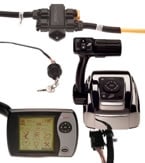
The Mercury DTS is available as a component of the company’s SmartCraft system, which allows the user to monitor the boat’s various systems from the helm.|
With DTS, there is no lag between throttle feed and engine response. “Eliminating cables is a major step just because of the typical deterioration and inaccessibility characteristics of cables,” explained Tom Ireland, Director of Saltwater Operations for Mercury Marine. “With DTS there is nothing to adjust. Shift and throttle selection is constant. It is repeatable every time.
“When I ran the first versions of this system, there was lag, and I said that was not acceptable,” Ireland continued. “If you are in tight quarters, or dealing with wind or current, you need to be able to react quickly. Now we have accomplished that. When people try DTS for the first time, their reaction is ‘the engines are so much more responsive.’ In fact, they are not. We have just eliminated play in the linkage, so there is no lost motion.”
Testing The System
We recently tested the DTS on an Angler center console at the Miami International Boat Show. It’s incredibly efficient and seamless. First of all, the throttles have a typical “electronic” feel – smooth and extremely sensitive. But where DTS differs from other electronic controls is in the speed of response. Because there is no intermediate motor to control a cable that leads to the engine, lag is nonexistent. If you have used electronic throttles, you know that, as in manual-cable systems, there is a slight lag you must adjust to. Of course, the amount of lag differs between electronic and mechanical controls, but it is still a factor.
With DTS it simply doesn’t exist because the actuators are linked directly to the motor. Punch the throttles to get on plane and the motor responds at once. The first impression is that the hull can’t quite get moving fast enough to keep up. It requires a different feel to jump on plane. There’s no punching it and then backing off the throttle as the rpm catches up. It’s an absolutely instant and accurate response of the engine to the position of the throttle lever. It’s real easy to get used to.
Every season sees new additions to what DTS can do. The original version lacked some of the more sophisticated features of control systems that have been around longer. However, it’s only a matter of programming the functions into the SmartCraft processor in order for DTS to perform any number of fancy tasks. And when those options are programmed in, it will be on a platform integrated with sophisticated, electronically controlled engines that is a quantum leap forward in outboard technology.
| ## Electronic Control Manufacturers/SuppliersGlendinning Marine Products (843) 399-6146 www.glendinningprods.comZF Mathers** (800) 546-5455 www.zf-marine.comTech Marine** (978) 772-6660 www.techmarine.comTeleflex Morse** (888) 236-2952 www.teleflexelectronics.comSturdy Corporation** (910) 763-2500 www.sturdycorp.comMercury Marine** (920) 929-5040 www.mercurymarine.comPrime Mover Controls** (604) 433-4644 www.pmc-controls.com |









